Kitesurfing in Mexico: Explore the Best Spots and Tips
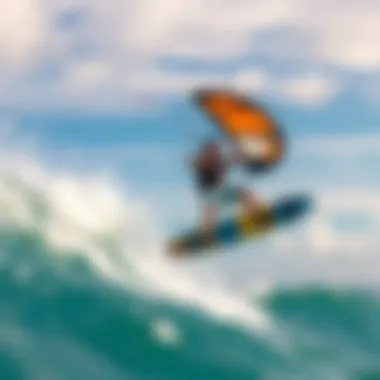
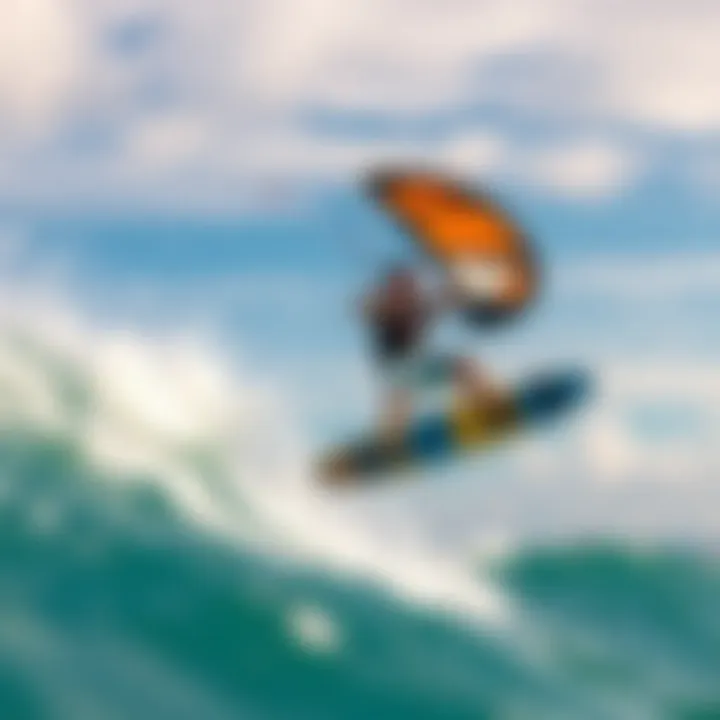
Intro
Kitesurfing in Mexico offers an adventure like no other, combining thrilling rides with the backdrop of stunning landscapes. This sport, blending elements of windsurfing, surfing, and paragliding, has captivated both locals and travelers alike. The Mexican coastline presents a unique playground where kiteboarders can immerse themselves in the local culture while navigating the waves.
The key to enjoying this water sport goes beyond just catching the wind in your sail; it involves understanding the essentials, from gear and equipment to mastering various techniques. Each beach holds its own charm, with distinct wind patterns, local customs, and conditions that can transform an ordinary kitesurfing session into an exhilarating experience.
In the upcoming sections, we will dive deeply into the gear necessary for riders at all levels, insightful tips to sharpen one’s skills, and how local culture enriches the kitesurfing community. Readers, whether novice or seasoned, will find valuable insights to enhance their kitesurfing journey in this captivating land.
Prelims to Kitesurfing
Kitesurfing, a thrilling water sport, combines elements of surfing, windsurfing, and paragliding. Understanding this sport is essential, especially when considering its popularity in vibrant locations like Mexico. Whether you're a newcomer or an experienced rider, grasping the nuances of kitesurfing not only enhances your skill set but also deepens your connection with the ocean and the wind.
Definition and Brief History
Kitesurfing involves riding on a small board while being propelled by a large kite. Though the origins might appear modern, in reality, kites have been around for centuries. The initial concept was utilized for various purposes, including fishing and farming. The first known instance of kitesurfing as a sport appeared in the late 20th century when enthusiasts began combining elements of surfing and kite flying.
The sport took off in the early 1990s. By the end of the decade, it had gained traction around the world, especially along coastlines with consistent winds and flat water. In Mexico, the sport boomed due to the country’s favorable weather and coastal conditions.
Why Choose Mexico for Kitesurfing?
If you're pondering where to shake the sand from your toes and hit the waves, Mexico should be at the top of your list. Several factors play into this recommendation:
- Diverse Locations: From Puerto Escondido's powerful waves to La Ventana's steady breezes, locations cater to every level of kitesurfer.
- Ideal Climate: With year-round warm temperatures and consistent wind patterns, Mexico is a paradise. The summer season brings specific kitesurfing conditions that make it particularly inviting.
- Thriving Community: The kitesurfing community in Mexico thrives. With local events, contests, and festivals throughout the year, you can easily connect with fellow riders. Whether they are locals or travelers, the passion for kitesurfing binds everyone together.
"Kitesurfing in Mexico is not just a sport; it’s a lifestyle, an adventure where every harnessing of the wind feels like discovering a new part of yourself."
Moreover, there are numerous schools and experienced instructors ready to share their knowledge. This accessibility ensures that both beginners and seasoned pros can improve their skills, making Mexico an excellent choice for anyone eager to ride the waves.
Top Destinations for Kitesurfing in Mexico
Kitesurfing is not just a sport; it’s a lifestyle, and choosing the right destination can make all the difference. In Mexico, the array of breathtaking locations, alongside a rich cultural backdrop, makes it a prime spot for kitesurfing enthusiasts. From windy shores to vibrant local communities, each destination offers its own unique experience, tailored to suit every skill level. Whether you are chasing the thrill of the perfect wave or simply want to soak up the sun, Mexico’s kitesurfing spots provide something for everyone.
Puerto Escondido
Puerto Escondido, known for its surf culture, is a hotspot for kitesurfing due to its consistent wind conditions. This surf town is often regarded as a kitesurfer's paradise, offering both inexperienced and seasoned riders a chance to thrive. The main beach, Zicatela, is often bustling with surfers; however, the lesser-known La Barra offers calmer waters, suitable for beginners.
- Wind Conditions: Typically, the best winds blow from May to October, creating ideal kite-flying weather.
- Activities: Besides kitesurfing, visitors can explore local cuisine centered around fresh seafood and participate in vibrant night events.
- Local Tips: Engage with local riders who knows the ins and outs of the area; they often share critical information that can enhance your experience.
Cancun
Cancun may be better known for its nightlife and luxurious resorts, but it also boasts excellent conditions for kitesurfing. The consistent trade winds and warm waters make it a favored destination, especially during the spring season. Its shallow lagoons allow beginners to practice without the fear of waves breaking over them.
- Accessibility: Cancun is easy to reach with its international airport serving numerous global destinations.
- Gear Rentals: Several shops offer quality equipment for those who don’t own their own gear, making it accessible for travelers.
- Cultural Experience: Unique excursions, such as visits to ancient Mayan ruins like Tulum or Chichen Itza, add an unforgettable layer to any kitesurfing trip.
La Ventana
La Ventana is often referred to as the hidden gem for kitesurfing enthusiasts. Nestled away from the bustling tourist spots, this town attracts those who embrace the sport in a more laid-back, natural setting. With stunning views of the Sea of Cortez and reliable summer winds, it has been increasingly popular among kitesurfers in recent years.
- Wind Patterns: October through April is known for the most exhilarating wind conditions, with some days reaching up to 30 knots.
- Kiteboarding Community: The local community is vibrant and filled with both experienced and newbie riders, making it easy to forge friendships and gather advice.
- Local Recommendations: Consider staying at one of the charming boutique hotels or campgrounds close to the beach for easy access to kitesurfing areas.
Sotavento
If there’s a place known for its flat water and steady winds in Mexico, it's Sotavento. Located in the Bahía de Pájaro de Playa, this area is famous for hosting international kitesurfing events. The large, shallow lagoon creates an ideal playground that caters well to both those just starting and the more proficient riders.
- Event Spot: Sotavento is renowned internationally and frequently hosts world-class competitions that attract top-tier athletes.
- Scenic Beauty: The natural scenery here is stunning, with desert landscapes meeting turquoise seas.
- Facilities: The area is equipped with multiple schools and rental shops to support any last-minute needs for kitesurfers.
Los Barriles
Los Barriles is a fantastic destination that caters to kitesurfers of all interests. Situated on the eastern coastline of the Baja Peninsula, this tranquil town offers scenic views and a welcoming atmosphere. Kitesurfing here usually enjoys winds ranging from moderate to strong, making it an excellent spot for various skill levels.
- Social Scene: The local kitesurfing community is friendly and welcoming, often organizing events or meet-ups.
- Rental Options: Several resorts and shops offer not only gear rentals but also classes, catering to beginners eager to get their feet wet.
- Local Attractions: Visitors can enjoy numerous other activities, from fishing to hiking, allowing a varied experience aside from kitesurfing.
"The combination of stunning landscapes and vibrant community makes Mexico a haven for kitesurfers, regardless of their skill level."
In summary, choosing a destination for kitesurfing in Mexico will not only enhance your skills on the water but also immerse you in a rich cultural experience. Each location has its own charm and set of advantages that can turn an ordinary trip into an extraordinary adventure.
The Ideal Conditions for Kitesurfing
Kitesurfing requires a unique combination of environmental elements, and Mexico provides an ideal backdrop for this exhilarating sport. Understanding the optimal conditions not only enhances the enjoyment but also ensures safety and performance. Each factor—the wind, water, and weather—plays a crucial role, allowing kiteboarders to maximize their skills while enjoying stunning coastal landscapes. By focusing on these aspects, riders can elevate their experience and ensure they make the best of their time on the water.
Wind Patterns and Seasons
Wind is perhaps the heartbeat of kitesurfing. It is what carries the kite and propels the rider across the water. In Mexico, wind patterns are influenced by various geographic and meteorological factors, providing consistent conditions throughout the year. The best times for kitesurfing usually fall within the dry season, typically from November to April.
- North and Northeast Winds: These winds, especially prevalent in spots like La Ventana, create perfect conditions for intermediate and advanced kitesurfers looking to test their skills.
- Thermal Winds: On the other hand, seasonal thermal winds can craft ideal environments during the summer months in places like Baja California.
- Local Variations: Different regions can yield distinct wind patterns, so it is wise to research the specific conditions of the chosen kitesurfing destination beforehand.
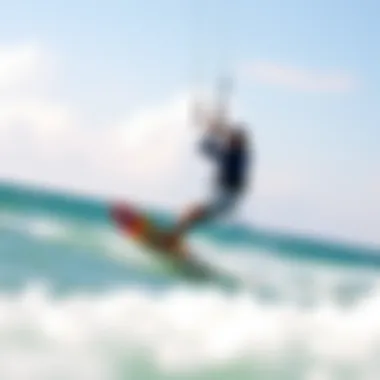
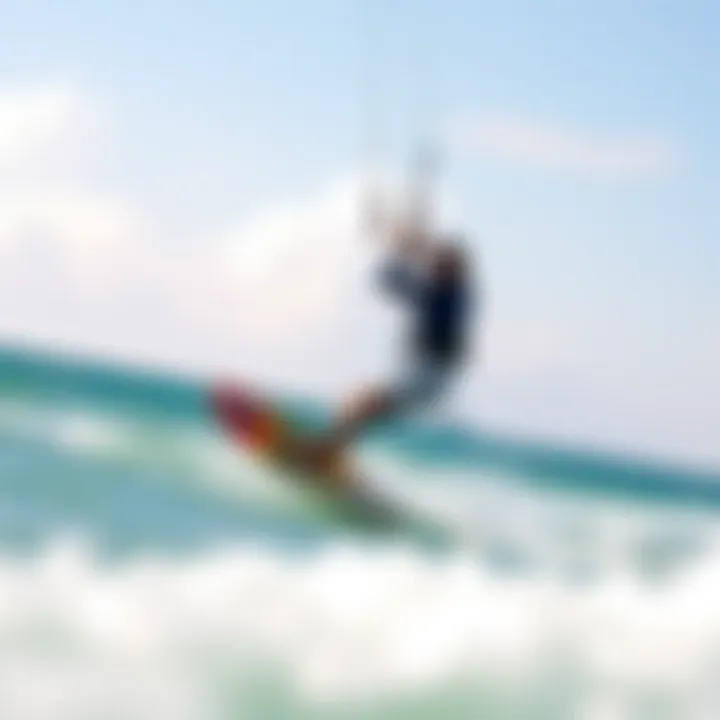
"Understanding local wind patterns makes the difference between flying high and staying grounded."
Water Conditions
Water conditions are equally critical for a successful kitesurfing experience. Mexico boasts diverse water environments—ranging from flat lagoons to wave-generated oceans—each offering unique experiences.
- Flat Water: Locations like Sotavento are known for their flat waters, which allow for smooth rides and make it easier to learn new tricks.
- Wave Riding: For those more adventurous, areas such as Puerto Escondido provide wave conditions, making it a favorite among experienced riders. In these regions, mastering the waves can take kitesurfing to altitudes previously unseen—both literally and figuratively.
- Water Temperatures: Warm waters are another benefit, as they make long sessions more comfortable. Generally, water temperatures in Mexican waters vary—and while spring and summer offer the warmest experiences, they're often delightful year-round.
Weather Considerations
Finally, understanding the weather is essential for any kitesurfer looking to enjoy their time on the water safely. In addition to wind and water, precipitation and temperature can greatly affect the overall experience.
- Clear Skies and Temperature: The dry season promotes consistent weather, with clear skies leading to more reliable wind conditions.
- Monitoring Weather Apps: To make the most informed decisions, checking apps like Windy or Windguru can provide real-time data on wind speeds and weather patterns.
- Seasonal Variability: Be mindful of tropical storms during the summer months, which can disrupt the ideal wind patterns and create dangerous conditions for kitesurfing.
In sum, the ideal conditions for kitesurfing in Mexico hinge on an intricate interplay of wind patterns, water conditions, and overall weather dynamics. By understanding these factors, kiteboarders can find themselves riding the waves safely and skillfully, turned out with ultimate satisfaction and a taste for adventure.
Essential Gear for Kitesurfing
When venturing into the world of kitesurfing, having the right equipment can make all the difference between an exhilarating ride and a frustrating experience. The gear one chooses affects not just performance but also safety and enjoyment. Thus, understanding the essentials of kitesurfing gear is crucial for anyone looking to ride the winds of Mexico’s breathtaking coastlines.
Whether you're a seasoned pro or starting out, having quality equipment tailored to your needs will enhance your kitesurfing experience.
Kite Selection
Choosing the right kite is fundamental to any kitesurfer's experience. Different kites are designed for various wind conditions and riding styles. Types of kites include:
- Bow Kites: Great for beginner to intermediate riders, offering stability and easy relaunching.
- C-Kites: Known for their agility and power, these kites cater to advanced riders seeking tricks and jumps.
- Hybrid Kites: Combining elements from both bow and C-kites; they provide versatility in various conditions.
When selecting a kite, factors such as size, wind range, and bar pressure play a pivotal role. A larger kite works well in lighter winds, while smaller models excel in high winds. Additionally, take into account your weight and skill level—someone weighing more may prefer a larger kite to float safely while beginners may benefit from smaller, more forgiving designs. Ultimately, investing in a kite that complements your style not only elevates your riding experience but can also ensure smoother transitions into more advanced techniques.
Board Types
Selecting a suitable board is just as vital as choosing the right kite. There are various types of boards tailored to different riding styles and conditions:
- Twin-Tip Boards: The most common type, great for all-around riding. These boards allow for easy landings and versatility in tricks.
- Directional Boards: Suitable for wave riding and those looking to emulate surfing styles. Directional boards require a certain skill level but provide an exhilarating experience in the waves.
- Celebrited Boards: These boards are specialized in performing certain tricks and having increased speed, often found in competition settings.
Each board offers distinct benefits—twin-tip boards are ideal for beginners focusing on learning basic techniques while directional boards offer challenges for those pushing the boundaries of their skills. Picking the right board enhances your ride, helping you to transition smoothly between learning and exploring advanced maneuvers.
Harnesses and Safety Equipment
Safety is paramount when it comes to kitesurfing, and that includes choosing the right harness and safety gear. A comfortable harness helps distribute the load and allows for greater control:
- Waist Harnesses: These provide freedom of movement while securing the rider to the kite. Perfect for those doing tricks.
- Seat Harnesses: Offer additional support and are ideal for novice riders who may need extra stability.
In addition to harnesses, appropriate safety gear is non-negotiable:
- Impact Vest: This adds buoyancy, protects against falls, and offers warmth in cooler waters.
- Helmet: A good helmet is essential for protection against impacts, particularly for those who enjoy jumping.
- Safety Leash: Ensures the kite can be quickly depowered in emergencies, hence preventing uncontrolled flights.
Taking the time to select the right harness and safety gear can minimize risks, making for a more enjoyable time on the water. With appropriate gear, you can focus more on the thrill of kitesurfing, free from potential worries about injuries from falls or accidents.
"Investing in quality equipment is the fabric of a great kitesurfing journey. It’s about setting yourself up for the best experience possible in Mexico’s splendid environments."
In summary, your gear forms the backbone of your kitesurfing experiences. From your kite selection, board type, and harness to safety equipment, every piece contributes to your adventure. So, as you pack your bags for Mexico’s coastlines, ensure every item is considered with care. With the right equipment at hand, you’ll be ready to enjoy all the spectacular moments kitesurfing has to offer.
Safety Measures When Kitesurfing
Kitesurfing is not just about the exhilarating feeling you get from riding the wind and waves; safety should be your first priority. Engaging in any watersport—especially one as dynamic as kitesurfing—requires understanding and implementing proper safety measures. These measures not only protect you but also ensure that your kitesurfing experience is enjoyable and memorable.
Understanding Local Regulations
Before you hit the water, it’s crucial to familiarize yourself with local regulations governing kitesurfing. Different regions in Mexico may have specific rules about where you can launch, land, and ride your kite. Here are a few guidelines to consider:
- Launch and Landing Zones: Know designated areas where it's safe to launch and land your kite. This helps prevent accidents with other riders or beachgoers.
- Kiteboarding Guidelines: Stay updated about specific kiteboarding guidelines set by local authorities. Certain places may have restrictions during peak tourist season to manage overcrowding.
- Permitting Requirements: Some regions may require permissions or permits for kitesurfing, especially in protected areas or national parks.
Violating regulations can not only put you at risk but may also tarnish the experiences of others. It’s a wise idea to reach out to local kitesurfing schools or community groups—they often have the straight skin on the dos and don’ts of the area.
Personal Safety Gear
Investing in appropriate personal safety gear is not just smart, it's essential. With the right equipment, you can significantly reduce the chances of injuries. Here’s a rundown of key gear:
- Helmet: Protects your head from impacts, especially during high speeds and tricky maneuvers.
- Impact Vest: Offers added buoyancy and protection against falls; it’s especially helpful when learning new tricks.
- Harness: A good harness transfers the pull of the kite to your body, allowing for better control. Make sure it fits properly to avoid discomfort.
- Safety Leash: Always use a safety leash that connects you to the kite! This crucial piece of gear can prevent a runaway kite from causing chaos.
Always inspect your gear before heading out. A well-maintained set is your best ally against unforeseen incidents.
Emergency Protocols
Even the best-laid plans can go awry, so knowing how to handle emergencies can make a world of difference. Here are some protocols you should drill into your memory:
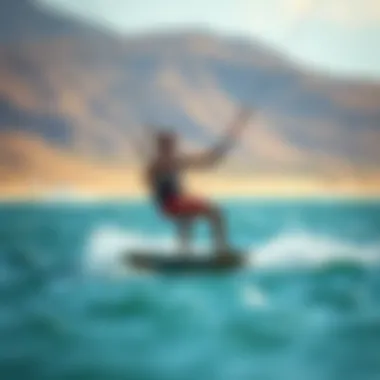
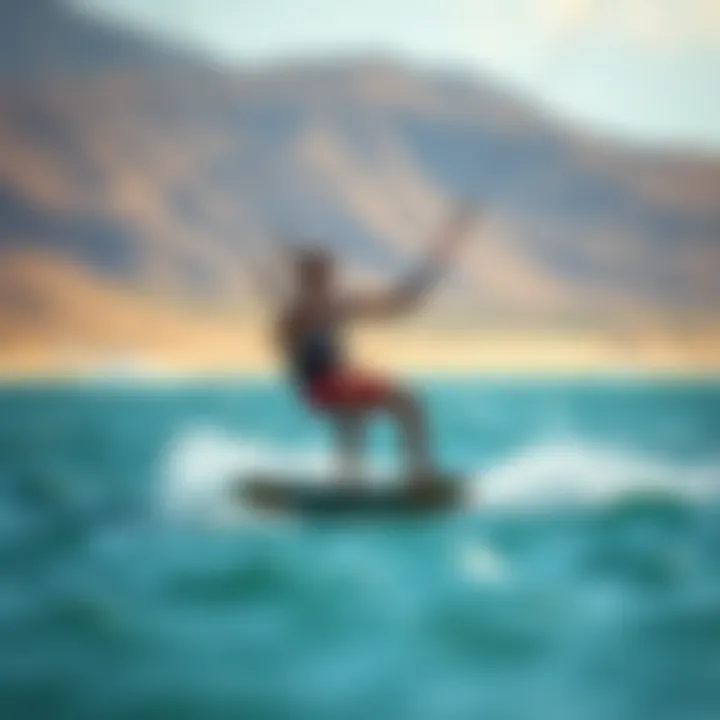
- Identifying Risks: Be aware of potential hazards in the water, like strong currents, nearby boats, or other kitesurfers. Staying informed can help you avoid dangerous scenarios.
- Signal for Help: Familiarize yourself with hand signals for emergencies, especially if you're riding in a group. Clear communication can save lives.
- Self-Rescue Techniques: Learn self-rescue techniques. In case you find yourself detached from your kite, being able to swim back to the beach or re-attach it is a skill that could come in handy.
- Local Emergency Contacts: Note down local emergency contact numbers and the nearest medical facilities. Accidents might happen, and knowing whom to call can expedite help.
Remember, being prepared is just as important as enjoying the sport.
By prioritizing safety and understanding the importance of each of these elements, you can fully immerse yourself in the joy of kitesurfing while keeping risks at bay. Combined with adherence to local regulations, the right safety gear, and emergency protocols, your time on the water can be both thrilling and secure.
Learning the Basics of Kitesurfing
Learning the basics of kitesurfing is absolutely essential for both newcomers and seasoned enthusiasts alike. The thrill of harnessing the wind and gliding over water can be both exhilarating and intimidating. Understanding the fundamentals not only decreases apprehension but also bolsters confidence on the board. The essence of kitesurfing lies in mastering the synergy between the kite and the directional board as it skims over the waves. Ignorance of the basics can lead to unnecessary risks and even accidents, which is why investing time in solid training is paramount.
Finding a School or Instructor
When embarking on your kitesurfing journey, the first decision to make is where to find a school or instructor. Thankfully, Mexico offers a plethora of renowned kitesurfing schools spread throughout its coastal treasures. It’s like a kid in a candy shop; there’s an abundance to choose from. The benefit of enrolling in a decent school is that you gain immediate access to structured training led by experienced instructors.
When selecting a school, consider looking for:
- Accreditation: Ensure the school is certified by recognized kitesurfing associations.
- Reviews: Check online platforms like Facebook or specialized kitesurfing forums on Reddit for feedback from past students.
- Facilities: A school that has up-to-date gear and safety equipment is vital. Quality tools can make or break your experience.
Whether you're in Playa del Carmen or the shores of La Ventana, a good instructor can turn your learning curve upside down, making the initial stages engaging rather than overwhelming. Don’t be shy to ask about their methods; after all, it's your safety and enjoyment that are at stake.
Initial Training and Lessons
Once you've chosen your kitesurfing school, the initial training will typically unfold over a combination of theoretical lessons and practical experience. A good instructor will introduce you to critical concepts, such as wind theory, safety measures, and equipment familiarization.
Your first lessons will focus on:
- Safety Protocols: Understanding how to respect the wind and conditions is vital.
- Kite Control: You’ll practice flying a trainer kite on land, learning to feel how the wind interacts with the kite.
- Body Dragging: Before you start riding, you'll likely learn to body drag, which means getting pulled through the water by the kite without the board. This skill is foundational, laying the groundwork for board starts.
Initial lessons can vary from a few hours in a day to a more extended multi-day course. By investing your time wisely and absorbing the foundational knowledge, you'll be setting yourself up for future thrills on the water.
Practice Techniques for Beginners
Once the groundwork has been laid with lessons and initial practice, it’s time to hit the water! Building muscle memory and honing your techniques is crucial as you begin this exciting adventure. Here are essential practice techniques beginners should focus on:
- Consistent Practice: Just as the saying goes, "practice makes perfect." Regularly hitting the water helps reinforce skills.
- Navigating Edge Control: Spend time mastering how to edge the board in the water. This control helps in both speed and dynamics.
- Falling Safely: Learn how to fall without panic. Understanding how to kitesurf safely includes knowing how to release the kite and position your body.
Throughout your practice, remember that improvement comes incrementally. Celebrate small victories, whether it's managing to keep up with the kite a little longer or getting a better grip on your board. The journey today is just as important as the destination you aim for tomorrow.
Advanced Kitesurfing Techniques
When one progresses beyond the basics of kitesurfing, the thrill of mastering advanced techniques becomes the next frontier. Advanced kitesurfing techniques are not just a series of flashy moves; they offer significant benefits such as improved efficiency, exhilarating experiences, and an enhanced connection with the elements. Mastering these techniques can elevate your performance and unlock a deeper sense of accomplishment in your kitesurfing journey.
Tricks and Maneuvers
In the world of kitesurfing, tricks and maneuvers are the heart and soul that keep the sport lively and exciting. These range from simple jumps and spins to complex aerial moves that leave spectators in awe. Some essential tricks include:
- Jumping: The cornerstone of kitesurfing tricks. A well-timed jump can showcase your control. It’s important to gauge wind strength and board speed to execute it effectively.
- Backrolls: This maneuver involves rotating backward in the air while keeping the kite steady. It requires a solid understanding of weight distribution and timing.
- Handle Passes: A challenging trick that requires you to pass the control bar from one hand to the other during a jump. This showcases skill and confidence, and it’s a crowd favorite.
- Kiteloops: An exhilarating maneuver where the kite loops dramatically while you are airborne. It’s incredibly fun but demands caution and a good grasp of your kite's responsiveness.
Engaging in these tricks not only raises your skill level but can also help you connect with the local kitesurfing community, which often takes pride in seeing friends and fellow riders progress. If you're looking to improve, consider practicing at locations known for their good, consistent conditions, such as La Ventana or Sotavento.
Overcoming Challenges
As with any sport, kitesurfing comes with its own set of challenges. Mastering advanced techniques is no walk in the park. It requires continuous practice, patience, and resilience. Internalizing various factors, such as wind conditions, board types, and kite dynamics, can make or break a rider’s performance. Here’s how to tackle some common obstacles:
- Fear of Falling: Many kitesurfers experience apprehension about trying new tricks, often fearing a hard fall. Starting with small, incremental steps helps build confidence.
- Wind Fluctuations: Kitesurfing regularly means contending with changing wind patterns. Familiarize yourself with the local weather apps or sites like windy.com to strategize better before heading out.
- Mistiming: Perfecting the timing for jumps and maneuvers can be tricky. One way to improve is to analyze videos of your practice sessions or watch experienced riders. Noticing the nuances can be remarkably beneficial.
"The only limit to our realization of tomorrow will be our doubts of today."
Remember, persistence is key. Engage with fellow kitesurfers to foster a supportive environment where everyone can share insights, techniques, and perhaps even their struggles.
In summary, advancing in your kitesurfing journey involves delving into the world of tricks and maneuvers while learning to navigate through the challenges that come with them. As you venture into this realm, the rewards will be immense, providing not just skill enhancement but an enriched experience of the sport.
Local Culture and Community
Kitesurfing in Mexico is more than just a thrilling water sport; it interweaves with the heart and soul of local culture, fostering a vibrant community that welcomes enthusiasts from around the globe. When you hit the waves, you're not just battling the elements but also connecting with a rich tapestry of traditions and contemporary influences. That sense of belonging can enhance the experience significantly, making every session on the water not just about kites and boards, but about shared passion.
Engagement with Local Riders
One of the beauties of kitesurfing in Mexico lies in the camaraderie among kiteboarders, both local and visiting. Many spots like La Ventana or Puerto Escondido have established a tight-knit community where knowledge is freely exchanged, creating a warm inviting atmosphere.
- Collaboration on Skills: When you engage with local riders, you're opening yourself up to tips and insights that can elevate your riding. Locals often know the subtle nuances of specific spots that you wouldn't find in any guide.
- Meet Outs and Group Rides: Often, these riders organize meet-ups and group riding sessions. Apart from enhancing skills, it's a great way to make friends who share the same adrenaline-fueled interest.
- Building Relationships: Forming connections with local riders can lead to lasting friendships. When you ride alongside someone who knows the area well, you get confidence to push your limits, trying new tricks and taking inspired risks.
Cultural Events and Gatherings
Throughout Mexico, kitesurfing events are not limited to riding the waves; they encapsulate local culture through festivities, competitions, and community gatherings. These occasions present multifaceted experiences that go beyond mere participation.


- Kiteboard Competitions: Events such as the La Ventana Classic not only showcase skill but also celebrate local talent among Mexican kiteboarders. It's a wonderful sight, with colorful kites filling the horizon while spectators cheer on their favorites.
- Festivals: Kitesurfing festivals often feature music, food, and dance, reflecting the vibrant Mexican culture. This creates a festive atmosphere where you can mingle, celebrate, and learn about the local heritage while enjoying the sport you love.
- Workshops and Clinics: Many cultural gatherings offer workshops led by seasoned riders or professionals, focusing on technique improvements or safety practices. These educational opportunities allow riders to refine their skills while immersing themselves in the cultural fabric of the region.
"Kitesurfing isn’t simply about the ride; it’s about the community and traditions that elevate the experience."
By understanding the local culture and actively engaging with the community, visitors can deepen their kitesurfing experience in Mexico. In essence, kitesurfing becomes not just a sport, but a rich, immersive journey into a culture that embraces nature, adventure, and togetherness.
Sustainable Kitesurfing Practices
Sustainable kitesurfing practices are increasingly important, especially in vibrant destinations like Mexico. Not only does this approach help preserve the stunning natural landscapes we cherish, but it also ensures that future generations of kiteboarders can enjoy the same exhilarating experiences that today’s adventurers do. Understanding the impact of our activities on the environment becomes crucial when you're gliding over pristine waters or riding the wind along coastlines that are as delicate as they are beautiful. This section dives into the importance of this theme, highlighting practical measures that both enthusiasts and novices can embrace.
Environmental Awareness
As kitesurfers, we often feel a deep connection to the environments we explore. Environmental awareness in kitesurfing includes recognizing the effects our presence can have on the local ecosystems. Whether it’s pollution or disturbance to wildlife, every action counts. For instance, littering—simplistic though it may seem—creates havoc, affecting not just our experience but also the delicate balance of local habitats. Here are some ways to focus on environmental awareness:
- Reduce Waste: Always pack light, and use refillable water bottles instead of single-use plastics. If you see trash, pick it up. Every bit helps.
- Choose Eco-Friendly Gear: Opt for kitesurfing equipment from brands that prioritize sustainability. This can range from recyclable materials to ethical manufacturing processes.
- Follow Local Guidelines: Be aware of any regulations regarding protected areas. Staying informed ensures you respect the natural beauty around you while enjoying your sport.
Respecting Local Ecosystems
Respecting local ecosystems is key for kitesurfers who wish to maintain the very beauty they enjoy. The windswept beaches and crystal-clear waters of Mexico are home to diverse flora and fauna, many of which face threats from human activities. By respecting these ecosystems, we can mitigate our impact and contribute to their preservation. Here are some practices to consider:
- Stay Within Designated Areas: Many coastal regions have specific zones for kitesurfing. Staying within these areas helps protect sensitive habitats.
- Educate Yourself: Learn about the local wildlife and vegetation. Understanding the importance of these components can foster a greater appreciation for their preservation.
- Engage with Local Conservation Efforts: Participate in clean-up events or other community initiatives. By integrating with local efforts, you can make a noticeable difference.
"The open ocean, much like the wind, is vast іn its beauty but frail in its balance. Every rider has the responsibility to honor that balance, ensuring the wave of enjoyment continues for years to come."
In summary, embracing sustainable kitesurfing practices is not merely a trend—it's a necessity for protecting the environment we love. Those who wander the beaches and ride the winds must do so with the knowledge that, to truly enjoy this lifestyle, we must also nurture and protect it. By being environmentally aware and respectful of local ecosystems, kitesurfers contribute to the longevity of the sport and the preservation of Mexico's breathtaking coastal landscapes.
For further insights on environmental conservation, resources like Wikipedia, or community forums like Reddit can be very helpful.
Travel Tips for Kitesurfing in Mexico
When you decide to go kitesurfing in Mexico, preparation is key. Jumping right into the sport without knowing the ins and outs can lead to some broken boards or bruised egos. The right travel tips not only ensure that your trip goes smoothly but can also enhance your overall experience.
Transport and Accessibility
Getting around in Mexico to reach prime kitesurfing locations isn't as daunting as it sounds, but understanding your options is vital. Public transportation can be hit or miss; it can either whisk you away to your destination or leave you waiting longer than your patience allows.
Renting a Car
One of the most convenient ways is to rent a car. Places like La Ventana and Sotavento are best accessed this way. It gives you the flexibility to explore at your own pace and allows you to carry all your gear without worry. Just be mindful of driving etiquettes; not everywhere runs on strict traffic rules.
Public Transportation
If you'd rather save a few pesos, buses are available, and they range from comfort to your local school bus experience. They can be quite economical, but prepare for a longer travel time. Sites like Rome2rio can help you find routes and options available.
"A little planning goes a long way in avoiding bumps on your kitesurfing journey."
Accommodation Options
Finding a place to lay your head after a day of kiting is another essential aspect. From affordable hostels to luxurious beachfront resorts, the options are wide and varied.
Hostels and Budget Stays
For those traveling on a budget, hostels or small hotels can be a good bet. Places near kite spots often have lively atmospheres, allowing you to connect with fellow kitesurfers. Look for spots in Puerto Escondido which typically offer easy accessibility to the water. Websites like Hostelworld can direct you to suitable options.
Beachfront Resorts
On the other hand, if you’re willing to splurge, beachfront resorts can provide a comfortable, all-in-one experience. Many of these resorts often offer packages that include kitesurfing lessons or equipment rentals. Checking on sites like TripAdvisor can help you find reviews and competitive pricing.
Local Rentals
Another possibility is to check if local riders offer rooms or other accommodation. Often, these can provide a more authentic experience and make you feel part of the vibrant community right away.
In summary, whether you’re riding solo or with friends, ensuring the travel arrangements and accommodations are sorted out in advance can make a world of difference. With the right plan in hand, you’ll find that the beauty of Mexico and its kitesurfing culture enriches your experience even further.
The End
The journey through the world of kitesurfing in Mexico not only highlights the stunning beauty of the landscape but also emphasizes the significance of embracing the sport with a mindful approach. This article encapsulates the intimacy of kitesurfing, merging thrills with an understanding of local cultures, safety, and sustainability. With amazing spots like Puerto Escondido and La Ventana, Mexico stands as a cherished playground for both newcomers and seasoned enthusiasts.
Summarizing the Experience
In summary, kitesurfing in Mexico offers a remarkable blend of adventure, community, and natural beauty. From the gentle breezes that beckon first-timers to the challenging waves that thrill veterans, each session tells a unique story. The waters of Mexico are not just for kitesurfing; they become a canvas where riders paint their experiences. The diversity of locations, ranging from the bustling beaches of Cancun to quieter spots like Sotavento, enriches every adventure.
The local culture, deeply intertwined with this sport, contributes a profound sense of belonging. Riders often find themselves welcomed into communities that cherish not only the sport but also the environment. Areas like Los Barriles exemplify this, where connections between locals and visitors flourish, making every kitesurfing session expand into a broader cultural experience.
Kitesurfing is not just about the ride; it's about the journey, the lessons learned, and the bonds forged along the way.
Encouragement for Involvement
As we conclude this exploration, there’s an open invitation for everyone—be it a curious traveler or a seasoned kiteboarder—to partake in this dynamic sport. The world of kitesurfing in Mexico is as welcoming as it is challenging. Whether you are looking to learn the ropes or enhance masterful tricks, countless resources and communities are ready to support your journey.
Consider visiting local schools, participating in local events, or even volunteering in environmental initiatives tied to the sport. These activities can deepen your experience, fostering connections with other riders and the surrounding environment. Remember, every wave caught brings with it the promise of new adventures and lasting memories. So grab your gear and let the winds guide your next move—Mexico awaits!















